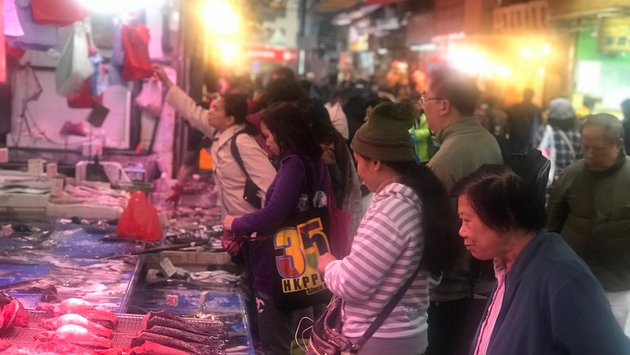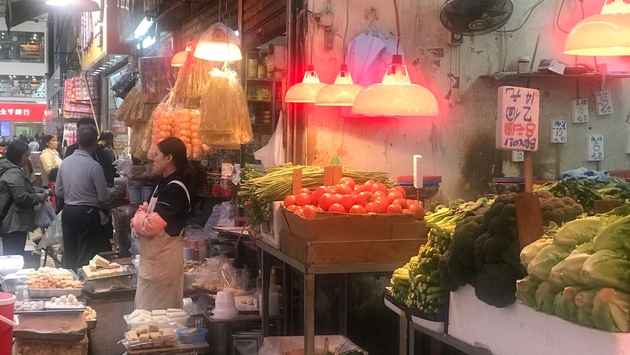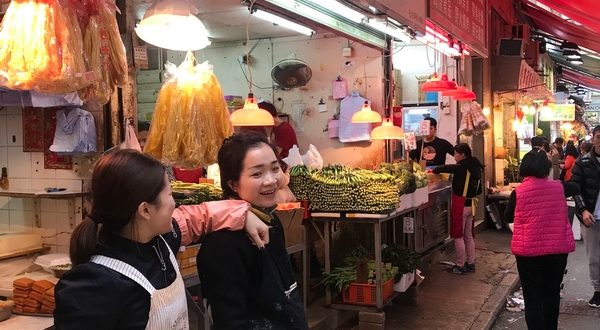[ad_1]
The portly frog and I eyed each other from afar. The frog looking like he hoped to break free from his cage at a Hong Kong wet market. Me, the sentimental, animal-loving vegan, wanting to set him loose.
Called Ting-gai in Cantonese, which oddly enough translates to mean “field chicken,” frogs are used in a variety of dishes in Hong Kong, particularly rice congee. They’re just one of the many types of animals on display at a wet market, a place where everything from poultry, to fish, and reptiles are sold out in the open.
The markets, which occupy streets and alleys, storefronts and stalls, are where many locals shop on a daily basis for food in Hong Kong.
They’re a vibrant hive of activity, a crush of people who come as much to socialize as to inspect the freshly cut slabs of meat, the carefully stacked pyramids of vegetables and all manner of shellfish, from oysters on the half shell to razor clams.
“This is the real Hong Kong,” my guide, Sidney Luk, told me. “People have contact with each other here. They can say ‘Hey, how was your day?’”
“Chinese people go to wet markets every day. When they see a product here, they know it’s fresh and it’s cheaper than going to a shopping mall,” Luk added.
As I learned during my recent visit, a wet market is clearly not for the faint of heart. Or for vegetarians or vegans. (Culinary daredevil Anthony Bourdain I am not, as much as I’d like to be.) The stacks of pig’s heads dangling on hooks, the innards on display, the severed goat heads with eyes still intact staring out at me, were a bit more than I had expected.
My visit to the market was prompted by a desire to see local life and experience the culture of everyday people in Hong Kong. I had spent days admiring the city’s famed skyscrapers, visiting posh rooftop bars sipping martinis and peering from observatories 100 stories in the sky designed to provide sweeping views of the architectural feat that is Hong Kong, a city that boasts the largest number of skyscrapers in the world.

Now it was time to explore the city up close, from the ground, immersed in the smells and sounds, the language and the streets. The wet market was my first stop during an afternoon of exploration.
The markets are increasingly attracting tourists in search of the “real Hong Kong.” As a result, locals are not unaccustomed to seeing foreigners amid the crowds of shoppers. But do yourself a favor and don’t get in anyone’s way as they’re shopping or doing business, as it’s not taken kindly. (Instagramers be warned).
My guide walked me through the throng, pausing every so often to explain how the various animals on display are used. Out of politeness to my host, I refrained from explaining that I’m a vegan.
The meat, fish, and vegetables sold at a wet market are displayed under dangling red lights designed to make the food look even fresher.
In some cases, customers want to see the animal live before it’s purchased. And many wet markets have facilities for allowing a buyer to choose a live animal, then take it home as is or see it killed and cleaned.
There are also tanks of snakes and turtles, both of which are used for soup. Ser geng, or snake soup, is believed to have medicinal benefits, warming the body and nourishing one’s blood.
Wildlife advocates and campaigners, however, have pointed out that the practice of making snake soup is cruel and unnecessary because the snakes are sometimes kept in inhumane conditions in snake farms in mainland China before being skinned alive, among other things.
Snake soup, turtle soup, my head started spinning and I made a dash for the safety of the nearest vegetable stand, an area I was far more comfortable with. Tomatoes and lettuce, just my speed I thought to myself. I was never so happy to see a benign stack of bok choy.

Whether or not my squeamishness was apparent to Luk, he didn’t miss a beat and transitioned to sharing details about fresh produce sales.
“Most fruits and vegetables come from the mainland,” he explained. “We’re highly dependent on the mainland. The border is just 50 minutes away.”
In a skyscraper-filled metropolis like Hong Kong, very few people have gardens or the space to grow their own food, my guide explained. Only the very rich, he said, have that luxury.
He also pointed out that many of the individual stalls in a wet market have been in a family for years and years. Often the individual working in the stall is elderly, in their 80s or 90s. That’s because the younger generation does not want to follow in the footsteps of their parents, doing such laborious work for a living.
Once a sparsely populated region of farming and fishing villages, Hong Kong is now one of the most significant financial centers and commercial ports in the world, which provides a great deal of promise for younger generations hoping to leap beyond such humble pursuits as selling food from a stall.
Hong Kong’s economy expanded by 2.9 percent year-on-year in the third quarter of 2018 after growth of 3.5 percent in the preceding quarter, marking the eighth consecutive quarter of growth. According to the government, Hong Kong continues to be the world’s freest economy.
But with all its glitter and possibility, and all of its economic freedom and growth, or perhaps because of these things, Hong Kong is an incredibly complex place that doesn’t represent the same level of promise for everyone.
The cost of housing can be prohibitive, particularly for young couples just starting out in life and few are able to own a home. As Luk explained to me, he and his wife have even opted not to have children because it’s simply too expensive. Both of them work long hours in order to make ends meet.
“In Hong Kong, there’s very little personal life. It’s all work,” Luk said.
The wet markets, however, continue to represent a simpler way of life. One that many people, including Luk, still enjoy experiencing. The markets allow for getting back in touch with a sense of community that has in some ways been lost amid all of the skyscrapers and malls and all of the growth and development.
For the most adventurous of tourists, wet markets also provide a glimpse of a far less polished and less modern side of Hong Kong. One you won’t soon forget, particularly if you’re the type who prefers observing animals running free in the wild, rather than as they wait to end up on a dinner plate.
[ad_2]You can read more of the news on source
 Travelsmart
Travelsmart



